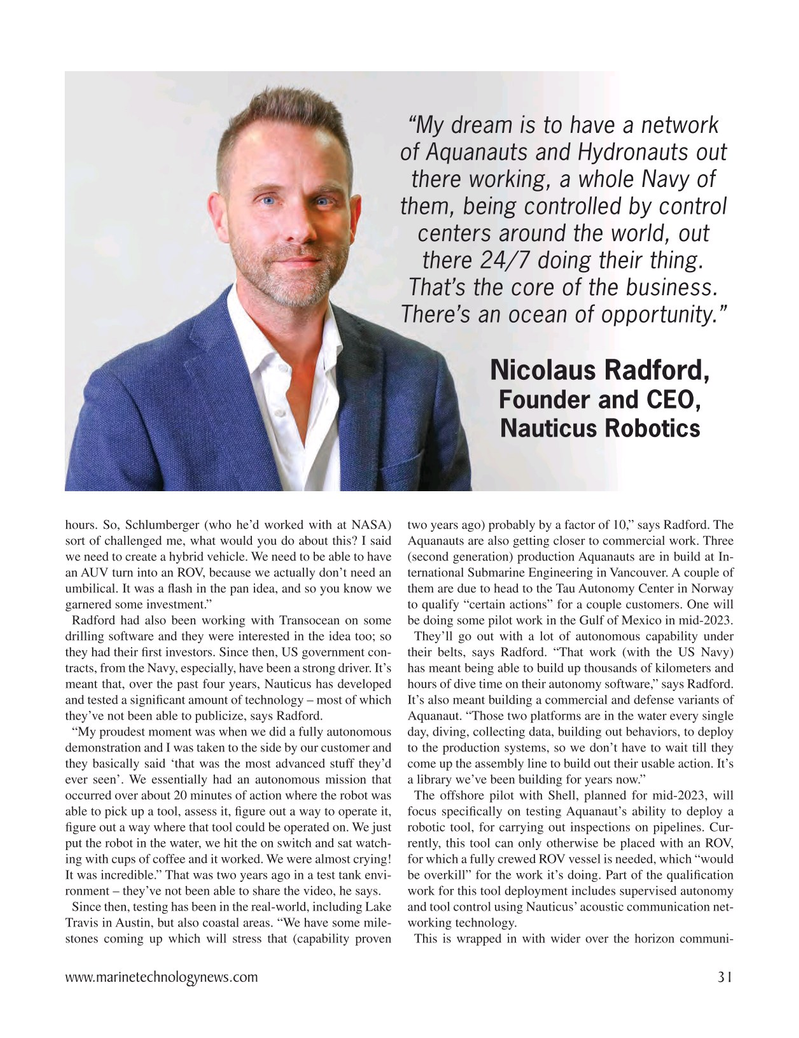
Page 31: of Marine Technology Magazine (January 2023)
Read this page in Pdf, Flash or Html5 edition of January 2023 Marine Technology Magazine
“My dream is to have a network of Aquanauts and Hydronauts out there working, a whole Navy of them, being controlled by control centers around the world, out there 24/7 doing their thing.
That’s the core of the business.
There’s an ocean of opportunity.”
Nicolaus Radford,
Founder and CEO,
Nauticus Robotics hours. So, Schlumberger (who he’d worked with at NASA) two years ago) probably by a factor of 10,” says Radford. The sort of challenged me, what would you do about this? I said Aquanauts are also getting closer to commercial work. Three we need to create a hybrid vehicle. We need to be able to have (second generation) production Aquanauts are in build at In- an AUV turn into an ROV, because we actually don’t need an ternational Submarine Engineering in Vancouver. A couple of umbilical. It was a ? ash in the pan idea, and so you know we them are due to head to the Tau Autonomy Center in Norway garnered some investment.” to qualify “certain actions” for a couple customers. One will
Radford had also been working with Transocean on some be doing some pilot work in the Gulf of Mexico in mid-2023. drilling software and they were interested in the idea too; so They’ll go out with a lot of autonomous capability under they had their ? rst investors. Since then, US government con- their belts, says Radford. “That work (with the US Navy) tracts, from the Navy, especially, have been a strong driver. It’s has meant being able to build up thousands of kilometers and meant that, over the past four years, Nauticus has developed hours of dive time on their autonomy software,” says Radford. and tested a signi? cant amount of technology – most of which It’s also meant building a commercial and defense variants of they’ve not been able to publicize, says Radford. Aquanaut. “Those two platforms are in the water every single “My proudest moment was when we did a fully autonomous day, diving, collecting data, building out behaviors, to deploy demonstration and I was taken to the side by our customer and to the production systems, so we don’t have to wait till they they basically said ‘that was the most advanced stuff they’d come up the assembly line to build out their usable action. It’s ever seen’. We essentially had an autonomous mission that a library we’ve been building for years now.” occurred over about 20 minutes of action where the robot was The offshore pilot with Shell, planned for mid-2023, will able to pick up a tool, assess it, ? gure out a way to operate it, focus speci? cally on testing Aquanaut’s ability to deploy a ? gure out a way where that tool could be operated on. We just robotic tool, for carrying out inspections on pipelines. Cur- put the robot in the water, we hit the on switch and sat watch- rently, this tool can only otherwise be placed with an ROV, ing with cups of coffee and it worked. We were almost crying! for which a fully crewed ROV vessel is needed, which “would
It was incredible.” That was two years ago in a test tank envi- be overkill” for the work it’s doing. Part of the quali? cation ronment – they’ve not been able to share the video, he says. work for this tool deployment includes supervised autonomy
Since then, testing has been in the real-world, including Lake and tool control using Nauticus’ acoustic communication net-
Travis in Austin, but also coastal areas. “We have some mile- working technology. stones coming up which will stress that (capability proven This is wrapped in with wider over the horizon communi- www.marinetechnologynews.com 31
MTR #1 (18-33).indd 31 1/22/2023 8:21:47 PM

 30
30

 32
32
